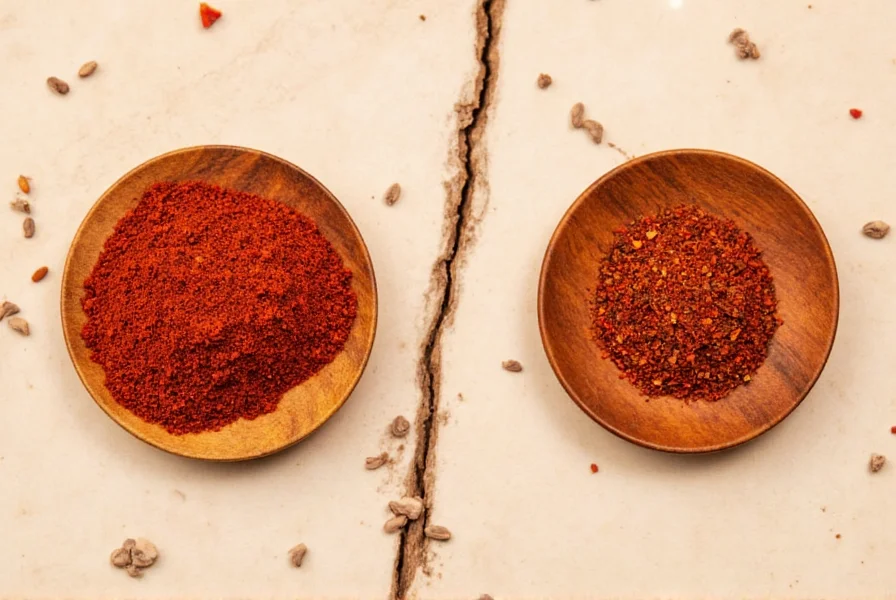Table of Contents
Introduction
Red pepper flakes and crushed red pepper are both made from dried chili peppers, but they differ significantly in texture, heat distribution, and culinary applications. Red pepper flakes have coarse, irregular pieces that provide visible texture and gradual heat release, while crushed red pepper is finely ground for seamless integration into sauces and soups. This guide explains exactly how to choose between them based on your recipe needs.
Key Differences Between Red Pepper Flakes and Crushed Red Pepper
| Characteristic | Red Pepper Flakes | Crushed Red Pepper |
|---|---|---|
| Texture | Coarse, irregular pieces with visible seeds and membranes | Finer, more uniform consistency with minimal visible pieces |
| Heat Distribution | Gradual release; heat builds slowly as you chew | Immediate and even heat distribution throughout the dish |
| Primary Use Case | Garnishing finished dishes (pizza, pasta, salads) | Blending into liquids (sauces, soups, marinades) |
| Heat Level Consistency | Variable heat due to uneven seed distribution | More consistent heat due to uniform grinding |
| Best Pepper Varieties | Cayenne, Fresno, or Thai chilies for balanced heat | California or Guajillo peppers for milder, fruity notes |
When to Use Each
Use red pepper flakes when:
- You want visible spice pieces for visual appeal (e.g., on pizza or pasta)
- Adding texture to finished dishes (grilled meats, roasted vegetables)
- Creating a slow-building heat effect in dishes like chili or stews
Use crushed red pepper when:
- Working with liquid-based dishes (marinara sauce, curry, soup)
- Need even heat distribution without visible specks
- Preparing dishes where texture shouldn't interfere with mouthfeel (smooth sauces, dressings)
Pro Tip: For Italian dishes, red pepper flakes are traditional for pizza and pasta, while crushed red pepper works better in tomato-based sauces where you want heat without visible pieces.
Substitution Tips
Yes, you can substitute one for the other, but with important adjustments:
- Flakes → Crushed: Use 25% less crushed red pepper (e.g., 1 tsp flakes = 3/4 tsp crushed)
- Crushed → Flakes: Add 20% more flakes and sprinkle at the end of cooking for texture
- For sauces: Crushed red pepper blends better; if using flakes, grind them finer with a mortar and pestle
- For garnishing: Only use flakes - crushed red pepper will disappear into the dish
Storage and Buying Guide
Storage: Keep both in airtight glass containers away from light and heat. Properly stored, they retain potency for 12-18 months. Avoid plastic containers which can absorb odors.
Buying Tips:
- Check the ingredient list: Should only say "dried red chili peppers" (no additives like anti-caking agents)
- Look for vibrant red color - faded brown indicates old product
- For flakes: Choose products with visible seed pieces for authentic texture
- For crushed: Opt for fine, powdery consistency without large chunks
- Buy small quantities (2-4 oz) to ensure freshness
Frequently Asked Questions
Are red pepper flakes and crushed red pepper the same thing?
No. While both come from dried red chilies, red pepper flakes maintain coarse, irregular pieces with visible seeds, while crushed red pepper is finely ground for smooth integration. The difference is in texture and how heat distributes in dishes.
Which one is hotter: red pepper flakes or crushed red pepper?
Neither is inherently hotter - heat depends on the chili variety used. However, red pepper flakes often have more seed distribution (where most capsaicin resides), which can create a more intense heat experience when chewed. Crushed red pepper distributes heat more evenly but may seem milder initially.
Can I use red pepper flakes in place of crushed red pepper for sauce?
Yes, but with adjustments. For sauces, grind the flakes finer using a spice grinder or mortar and pestle, then add them earlier in cooking. Alternatively, strain the sauce after cooking to remove visible pieces for a smoother texture.
Why do some recipes specify one over the other?
Recipes specify based on texture requirements. Flakes are used when you want visible spice pieces and a crunchy finish (e.g., pizza), while crushed red pepper is chosen for dishes where heat must blend seamlessly into liquids without noticeable particles (e.g., marinara sauce).
How do I store red pepper flakes and crushed red pepper?
Store both in airtight glass containers away from light, heat, and moisture. A cool, dark cupboard is ideal. Avoid storing above the stove. Proper storage maintains flavor and potency for 12-18 months. Do not refrigerate, as moisture can cause clumping.











 浙公网安备
33010002000092号
浙公网安备
33010002000092号 浙B2-20120091-4
浙B2-20120091-4